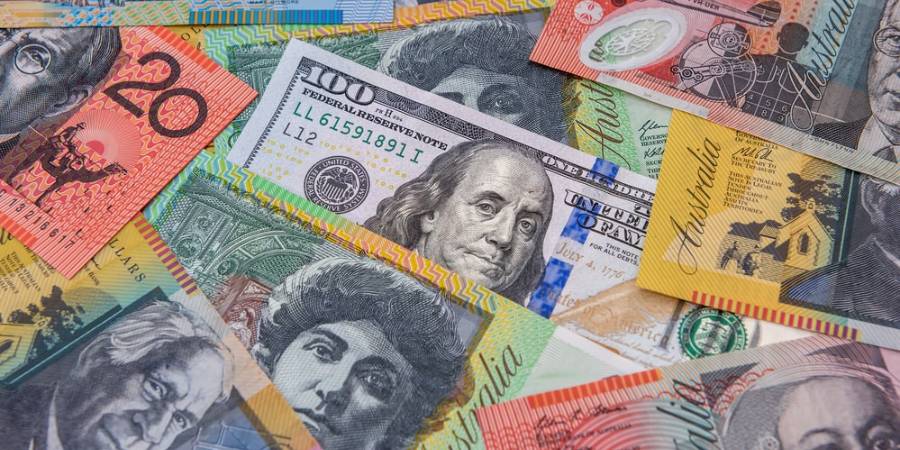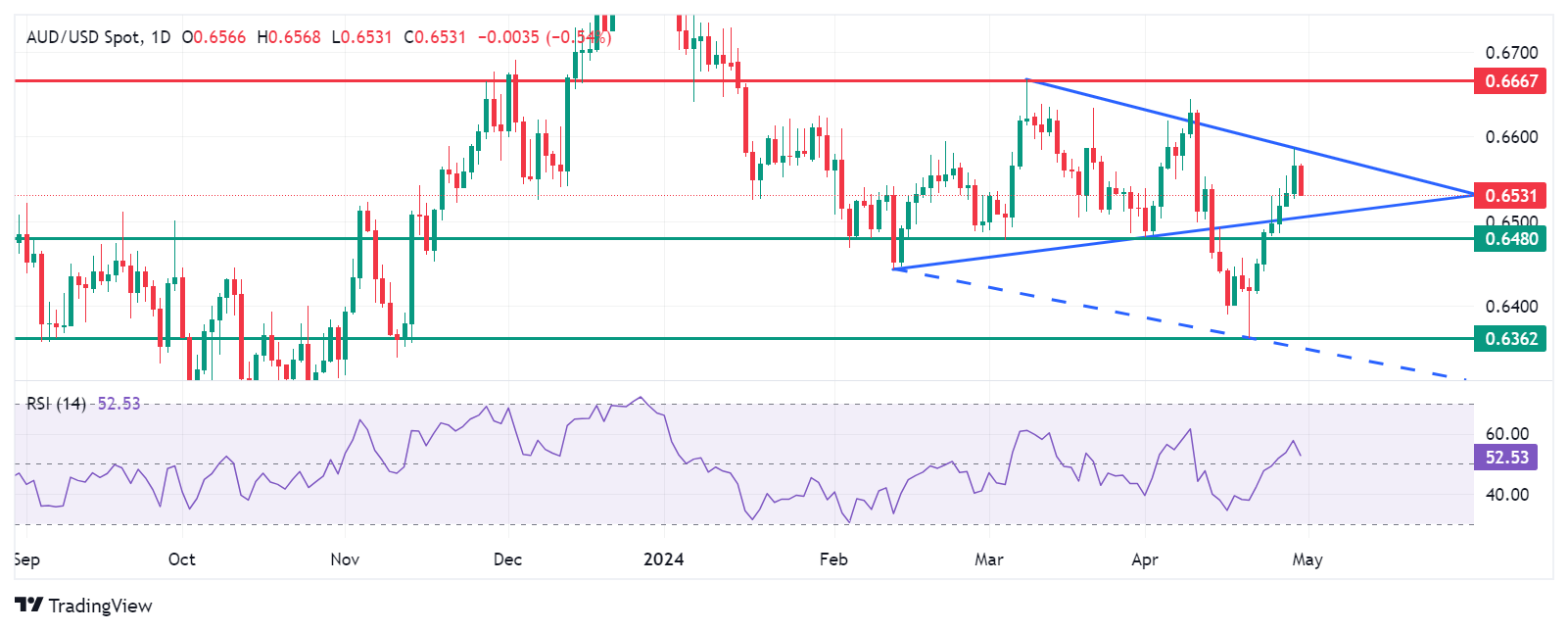Australian Dollar loses ground after softer Retail Sales amid higher US Dollar

■The Australian Dollar has weakened following the release of softer Retail Sales data.
■The Australian Dollar could regain ground due to growing expectations of the RBA delaying interest rate cuts.
■The US Dollar has rebounded, possibly from hawkish comments made by Fed officials, signaling no immediate necessity for rate cuts.
The Australian Dollar (AUD) extended its downward correction following Tuesday's release of lower than expected domestic Retail Sales data. Retail Sales are a key leading indicator directly correlated with inflation and growth prospects, potentially influencing the Reserve Bank of Australia's (RBA) hawkish stance on interest rate trajectory.
The Australian Dollar could potentially regain its footing, buoyed by higher-than-expected domestic inflation data released last week, which has raised expectations that the RBA may delay interest rate cuts. Furthermore, Commonwealth Bank, Australia's largest mortgage lender, has revised its forecast for the timing of the first interest rate cut by the RBA, now projecting only one cut in November, as reported by the Financial Review.
The US Dollar Index (DXY), which gauges the performance of the US Dollar (USD) against six major currencies, has rebounded following hawkish remarks from US Federal Reserve (Fed) officials, indicating no immediate need for rate cuts.
Traders are anticipated to await Wednesday's release of the ADP Employment Change and ISM Manufacturing PMI from the United States (US), alongside the Fed Interest Rate Decision. These events are likely to influence market sentiment and USD movement.
Daily Digest Market Movers: Australian Dollar depreciates after lower Retail Sales
The seasonally adjusted Australian Retail Sales experienced a 0.4% month-on-month decrease in March, falling short of expectations for a 0.2% increase. This decline contrasts with the previous month's growth of 0.3%.
In April, China's NBS Manufacturing Purchasing Managers Index (PMI) declined to 50.4, down from the previous reading of 50.8. Although it was higher than the expected reading of 50.3. Additionally, the Non-manufacturing PMI decreased to 51.2, in line with expectations, compared to the previous reading of 53.0 in March.
The International Monetary Fund (IMF) stated in its latest report, released on Tuesday, that China's economic growth is anticipated to decelerate in the coming years. The projected growth rates are 5.2% in 2023, 4.6% in 2024, and 4.1% in 2025. This forecast has implications for the Australian market, as Australia is the largest exporter of commodities and raw materials to China.
Australian shares kicked off Tuesday with little change, as investors paused ahead of the upcoming US Federal Reserve rates decision on Wednesday. Among the 11 sectors, only materials showed gains, while the rest remained relatively unchanged.
According to the CME FedWatch Tool, the probability of the Federal Reserve keeping interest rates unchanged in the June meeting has increased to 88.4%, up from 83.5% in the past week. The Fed's narrative of higher rates for a longer period strengthens the US Dollar and presents a challenge for the AUD/USD pair.
The Economic Times reported on Monday that Fed Chair Jerome Powell mentioned it would likely take "longer than expected" to gain confidence that inflation is progressing towards the central bank's 2% target. Powell added that the central bank can maintain rates at a high level "as long as needed." Fed Governor Michelle Bowman expressed her view of "upside risks" to inflation. Meanwhile, Minneapolis Fed President Neel Kashkari raised the possibility of no rate cuts occurring this year.
Technical Analysis: Australian Dollar moves below 0.6550
The Australian Dollar trades around 0.6530 on Tuesday. The pair remains within the symmetrical triangle, with the 14-day Relative Strength Index (RSI) positioned above the 50-level, affirming a bullish stance.
In terms of potential upward targets, the AUD/USD pair may test the triangle’s upper boundary around the level of 0.6585, followed by the psychological barrier at 0.6600 and subsequently aim for March’s high of 0.6667.
On the downside, the AUD/USD pair could test the lower boundary of the symmetrical triangle, aligned with the major support of 0.6500. A break below the major support of 0.6480 could lead the pair to reach April’s low of 0.6362.
AUD/USD: Daily Chart

Australian Dollar price in the last 7 days
The table below shows the percentage change of the Australian Dollar (AUD) against listed major currencies in the last 7 days. The Australian Dollar was the strongest against the Japanese Yen.
|
USD |
EUR |
GBP |
CAD |
AUD |
JPY |
NZD |
CHF |
USD |
|
-0.48% |
-1.58% |
-0.15% |
-1.32% |
1.24% |
-0.51% |
-0.02% |
EUR |
0.48% |
|
-1.11% |
0.33% |
-0.82% |
1.66% |
-0.02% |
0.45% |
GBP |
1.56% |
1.09% |
|
1.42% |
0.27% |
2.79% |
1.07% |
1.55% |
CAD |
0.15% |
-0.33% |
-1.42% |
|
-1.15% |
1.39% |
-0.35% |
0.13% |
AUD |
1.29% |
0.81% |
-0.29% |
1.13% |
|
2.52% |
0.79% |
1.27% |
JPY |
-1.25% |
-1.74% |
-2.87% |
-1.42% |
-2.59% |
|
-1.77% |
-1.28% |
NZD |
0.51% |
0.01% |
-1.07% |
0.35% |
-0.80% |
1.75% |
|
0.47% |
CHF |
0.04% |
-0.45% |
-1.57% |
-0.13% |
-1.27% |
1.26% |
-0.46% |
|
The heat map shows percentage changes of major currencies against each other. The base currency is picked from the left column, while the quote currency is picked from the top row. For example, if you pick the Euro from the left column and move along the horizontal line to the Japanese Yen, the percentage change displayed in the box will represent EUR (base)/JPY (quote).
* The content presented above, whether from a third party or not, is considered as general advice only. This article should not be construed as containing investment advice, investment recommendations, an offer of or solicitation for any transactions in financial instruments.


